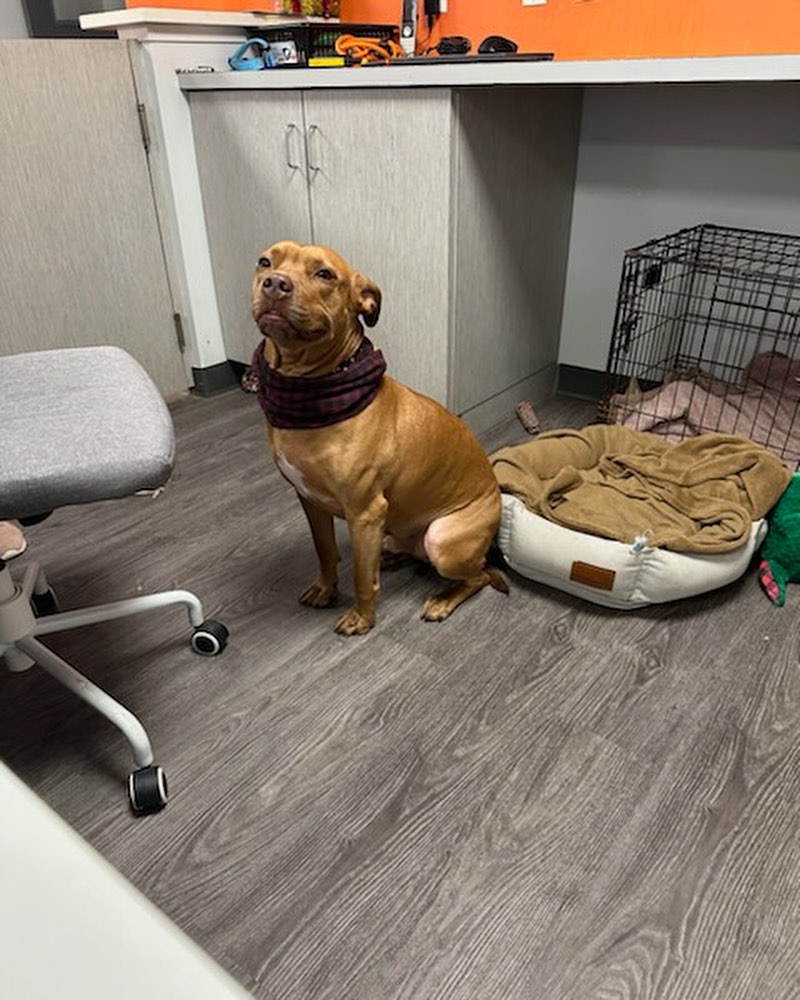It is no secret that Pitties are one of the most misunderstood breeds in the world. Their sturdy exterior and violent past often don’t do them justice, especially when you know that they can be just as sweethearts as other dogs.
For Dexter, the tan, Georgia Pittie, life started pretty roughly.
He was stuck in a shelter after roaming the streets for such a long time. And, the worst thing of all? Nobody wanted to give him a second look, ultimately leading this boi to inevitable euthanasia…
The Last-Minute Rescue

Dexter was picked up as a stray dog in Georgia in 2019. When he was initially found, he was 20 to 25 pounds underweight and missed a great deal of his fur due to sun damage and poor living conditions.
After he ended up in a local shelter, his misery was prolonged. Instead of finding a home, Dexter became the pup nobody wanted. Until, one day, the giant-hearted people stumbled across him!
“He was just hunched down in the shelter, looked very sad. His paperwork said: “Big, tan guy.” He did not have a name, and because he had no interest or applications, he was going to be put on the euthanasia list,” Mark told GeoBeats Animals.

Thanks to Fly With Me Animal Rescue, who originally saved Dexter from the shelter, Mark Romans and his fiance got the opportunity to meet this sweet boi – and keep him in their home for good.
From the moment they met, Dexter and Mark formed a special bond. The two clicked right off the bat, unknowingly embarking on a beautiful journey of friendship – the one that lasts forever and beyond!
Who’s The Sweetest Pup In The House?

It took Dexter less than a few weeks to show everyone who the sweetheart of the house was!
Even though he was officially picked up from the streets as a stray, it was more than evident that Dexter had a home before. He was house trained, knew how to behave indoors, and immediately enjoyed taking cozy naps on the couch!
But, there was one thing Dexter loved more than anything – his family! That’s why Mark and his fiance decided to expand their little pack by adopting a feline girl into their home.
Zoe, who was only a kitten back then, was embraced with an open heart, and Dexter just loved having her around!
The two soon became best friends who didn’t know life without each other. And, those brother-sister fights? Or, the infamous cat-dog rivalry? That just never existed in Dexter and Zoe’s relationship.
Dexter Is More Than Just A Good Pet

For Mark, having Dexter in his life was never just a matter of companionship, but so much more. Recently, this giant-hearted man has been diagnosed with lupus, and his biggest support is Dexter!
Coping with this autoimmune disease, this tan furry hero has done more for his dad’s mental health than anyone else. He’s the best healthcare provider and makes sure to always be in tune with Mark’s energy.

Without saying a word, Dexter knows exactly how to make his dad smile, or what to do in order to cheer him up.
Yet, some people still have lots of stereotypes when it comes to his breed. Occasionally, people direct a negative comment toward Dexter based on his breed, which gave Mark an idea – to establish an advocate group called East Coast Bully Advocates.
“We were just walking on our boardwalk. A senior elderly lady walked by and she looked at us and said: ‘That thing’s gonna get you in your sleep one night, you know?’ So that actually caused me to go found a page East Coast Bully Advocates,” said Mark.
Today, the organization has made unbelievable success, being responsible for saving hundreds of rescue dogs’ lives!
Mark will continue to show how much Pitties are an underestimated breed, and Dexter will be there to serve as the pawfect testament to it!
“No matter how much hate I receive for owning a Pitbull I will always continue to show how much love these dogs have and how truly misunderstood they are,” Mark wrote on Instagram.
Once a stray, Georgia dog, Dexter is now a true friend, a sibling, a caregiver, and the best companion one could ever wish for!
If you’ve ever noticed your furry friend scratching their ears more than usual, they might have picked up some unwanted visitors – ear mites. These tiny parasites can be a common nuisance for dogs, causing discomfort and irritation in their ears. As a seasoned dog enthusiast, you understand the importance of keeping your pup healthy and happy, so knowing how these pesky critters find their way into your dog’s ears is essential.
Picture this: your playful pup exploring the outdoors, sniffing around, and having a grand old time. Little do they know that during their adventures, they could come into contact with other infected animals or contaminated environments where ear mites thrive. As a responsible pet owner, being aware of how dogs can easily pick up these bothersome pests is crucial in maintaining your dog’s well-being.
Understanding Ear Mites in Dogs
When it comes to your furry companion’s well-being, understanding ear mites is essential. These tiny parasites, known as Otodectes cynotis, are often the culprits behind your dog’s ear discomfort. Here’s what you need to know about them:
- How Ear Mites Infect Dogs: Ear mites are highly contagious and easily transmitted between animals. When your dog comes into contact with an infected animal or contaminated environment, these pesky mites can hitch a ride into their ears, leading to irritation and itching.
- Signs of Ear Mite Infestation: If your dog is constantly scratching their ears or shaking their head, it could be a sign of ear mites. Other symptoms include redness, inflammation, and a dark discharge resembling coffee grounds in their ears.
- Diagnosing Ear Mites: To confirm an ear mite infestation, your vet will examine your dog’s ears using an otoscope. They may also take a sample of the ear discharge to identify the presence of mites under a microscope.
- Treatment Options: Thankfully, ear mites can be effectively treated. Your vet may prescribe medicated ear drops or a topical solution to kill the mites. It’s essential to follow the treatment plan diligently to ensure the mites are fully eradicated.
- Prevention is Key: To protect your dog from ear mites, it’s crucial to maintain their hygiene and regularly clean their ears. Additionally, avoid contact with animals known to have ear mites and keep their environment clean to minimize the risk of infestation.
By understanding how ear mites affect your furry friend and taking proactive steps to prevent and treat infestations, you can ensure your dog’s ears stay healthy and itch-free.
Causes of Ear Mites in Dogs
When it comes to the causes of ear mites in dogs, there are a few key factors to consider:
- Contact with Infected Animals: Dogs can easily pick up ear mites from coming into contact with other animals that are already infested with these pesky parasites.
- Contaminated Environments: Your dog can also get ear mites by spending time in areas where mites are present, such as parks or kennels.
- Transmission: Ear mites are highly contagious and can spread quickly from one pet to another, especially in multi-pet households.
- Lack of Hygiene: Poor hygiene practices, like infrequent ear cleaning, can create an environment where ear mites thrive.
- Weakened Immune System: Dogs with compromised immune systems are more susceptible to ear mite infestations.
To prevent ear mites in your furry friend, it’s essential to keep their living environment clean, limit contact with unknown animals, and schedule regular vet check-ups to catch and treat any issues early on. By being proactive in your approach, you can help your dog avoid the discomfort and irritation caused by ear mites.
Signs and Symptoms of Ear Mites in Dogs
When it comes to ear mites in dogs, it’s essential to recognize the signs and symptoms so you can address them promptly. Here are the key indicators to look out for:
- Ear Scratching: If your pup is constantly scratching their ears or shaking their head more than usual, it could be a sign of ear mites.
- Head Tilting: Notice your furry friend tilting their head to the side frequently? This could indicate discomfort caused by ear mites.
- Dark Discharge: Keep an eye out for dark, crusty discharge or a strong odor coming from your dog’s ears, as this may signal an ear mite infestation.
- Redness and Swelling: Check your dog’s ear flaps for any redness, swelling, or inflammation, which can be a common symptom of ear mites.
- Hair Loss Around Ears: If you observe hair loss around your dog’s ears, especially accompanied by other symptoms, it could be due to ear mites.
Being vigilant about these signs and symptoms of ear mites in dogs can help you take timely action to alleviate your furry companion’s discomfort. Regularly inspecting your dog’s ears during grooming sessions and seeking veterinary advice at the first sign of trouble can make a significant difference in your dog’s ear health.
Diagnosing and Treating Ear Mites in Dogs
When it comes to dealing with ear mites in your furry friend, early detection is key. Here’s what you need to know about diagnosing and treating ear mites in dogs:
Symptoms to Watch Out For
Keep an eye out for common signs that could indicate your dog has ear mites. These include:
- Excessive Scratching: If your dog is constantly scratching their ears, it could be a sign of mites.
- Head Shaking or Tilting: Unusual head movements might signal an ear mite infestation.
- Dark Discharge: A dark, coffee-ground-like discharge in the ears could be indicative of mites.
- Redness and Swelling: Irritation, redness, or swelling around the ears may be a symptom of ear mites.
- Hair Loss: Loss of hair around the ears is another potential sign of ear mites.
Seeking Veterinary Assistance
If you notice any of these symptoms, it’s crucial to seek veterinary help promptly. Your vet can perform a thorough examination to confirm the presence of ear mites. They may use an otoscope to inspect the ears and recommend appropriate treatment based on their findings.
Treatment Options
Treatment for ear mites typically involves cleaning the ears to remove debris and administering medication to eliminate the mites. Your vet may prescribe ear drops or topical medications to eradicate the mites effectively.
Home Care and Prevention
In addition to veterinary treatment, maintaining good ear hygiene is essential in preventing future ear mite infestations. Regularly clean your dog’s ears with veterinarian-approved solutions to help prevent a recurrence of ear mites.
Remember, the earlier you address ear mite issues in your dog, the sooner they can find relief from discomfort and prevent potential complications. Regular check-ups and prompt treatment are crucial for keeping your furry companion healthy and happy.
Dealing with Ear Mites Recurrence
When it comes to dealing with ear mites recurrence in your furry friend, prevention is key. To keep these pesky parasites at bay, you must ensure that your dog’s environment is clean and free from potential sources of infestation.
Regular cleaning of your dog’s bedding, toys, and living areas can go a long way in preventing ear mites from coming back. By maintaining a clean environment, you reduce the chances of a recurrence and help keep your dog happy and healthy.
Additionally, limiting your dog’s contact with unknown animals can help prevent the spread of ear mites. Be cautious when introducing your dog to new furry friends, as this can be a common way for ear mites to reappear.
If you notice any signs of ear mites returning, such as increased scratching, head shaking, or discharge, consult your veterinarian immediately. Early detection is crucial in preventing a full-blown infestation and ensuring your dog’s comfort.
Your vet may recommend follow-up treatments to control the recurrence of ear mites. It’s essential to follow their advice diligently to keep these parasites at bay and maintain your dog’s ear health.
By staying proactive, maintaining cleanliness, and seeking prompt veterinary care, you can effectively deal with ear mites recurrence and provide your furry companion with the best care possible.
Conclusion
That’s it for understanding how dogs get ear mites. Remember, prevention is key! Keeping your furry friend’s ears clean and avoiding contact with unfamiliar animals can go a long way in protecting them. Stay vigilant for any signs of ear mites, such as scratching or dark discharge, and act promptly if you suspect a recurrence. Your furry pal’s health is in your hands, so stay proactive and keep those ear mites at bay for a happy and healthy pup!
Frequently Asked Questions
What are the common signs of ear mites in dogs?
Ear mites in dogs often lead to symptoms like constant ear scratching, head shaking, dark discharge in the ears, redness, swelling, and hair loss around the ears.
How can ear mites in dogs be diagnosed?
A veterinarian can diagnose ear mites in dogs by examining a sample of ear debris under a microscope to identify the mites or their eggs.
What is the treatment for ear mites in dogs?
Treatment for ear mites in dogs involves thorough cleaning of the ears and administering appropriate medications as prescribed by a veterinarian.
How can ear mites in dogs be prevented?
Preventing ear mites in dogs involves maintaining a clean living environment, limiting contact with unfamiliar animals, and seeking prompt veterinary care if symptoms arise.
What if ear mites in dogs recur?
If ear mites in dogs reoccur, it’s crucial to follow up with your veterinarian for additional treatments and focus on preventative measures like regular ear cleaning and minimizing exposure to potential sources of infection.
[no_toc]

Hey there, I’m Janet Brooks, a dog-loving student from California. I’m all about helping pups in need, especially those without homes. Me and my awesome friends work together to give shelter and love to stray dogs. Oh, and I also write blogs about dogs to share helpful info.